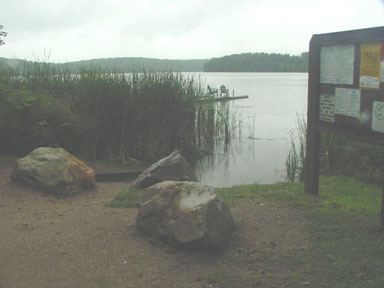 | ||
Similar Bear Mountain, Mount Riga State Park, Scoville Memorial Library, Lillinonah Trail, Great Smoky Mountains | ||
The Twin Lakes of Salisbury, Connecticut are Lakes Washinee and Washining, whose supposed identities as twins seem in conflict with their dissimilar size and shape. However, they are called the "twin lakes" not because of their size and shape, but because of their namesakes, two daughters of a Mahican chief.
Contents
- Map of Twin Lakes Salisbury CT 06068 USA
- Geography
- Etymology
- History
- West Twin Washinee
- East Twin Washining
- Zebra Mussels
- References
Map of Twin Lakes, Salisbury, CT 06068, USA
Geography
Lake Washinee is about 1.6 miles (2.6 km) long, and under a quarter mile (0.4 km) wide of except for its squarish roughly 0.5 by 0.6 mile (0.8 by 1.0 km) southernmost section. Its deepest part is around 21 feet.
Lake Washining is much rounder, and roughly 0.9 by 1.3 miles (1.5 by 2 km). It has a maximum depth of 80 feet. Much of the shore is wetland, but there are some private residences. There is a thermocline that forms around 15 feet.
Twin Lakes is located in Salisbury, Connecticut; approximately 5 miles away from the Massachusetts, Connecticut and New York border.
The two lakes are separated by an isthmus under 300 feet (100 m) wide, and they maintain the same water level. They are located in the Housatonic Valley in northwestern Connecticut. Near the 'Between the Lakes Road' is located a series of limestone caves, including the Bashful Lady Cave, one of the longest in the state.
Etymology
Washinee ‘Smiling Water’ and Washining ‘Laughing Water’ are romanticized, made-up meanings for the twin equal lakes; no Amerindian would think of places in that way. On consulting John C. Huden’s Indian place names of New England, NY, 1962, Museum of the American Indian—Heye Foundation, one can find the following entry, p. 271: Washining Litchfield County, Conn. Mahican, ‘mountain country’ or perhaps a corruption of Ossining, ‘stony land’. Variant, Washee. [Also Washinee.] There are some problems here. The first element Wash- seems similar to Massachusett wadchu ‘mountain, hill’, but the medial element -in- can’t be explained, and the final element -ing would seem to be clear enough as ‘at the place of’, but that last would imply a Delaware (Munsee, Unami) word and not Mahican, which used -uk (like /uck/ in English). So let’s bypass Huden’s first idea, but Delaware “Ossining” (‘stone-at’) matches extremely well Washining. Is there a lot of stoniness around those twin lakes? However, Mahican ‘stone’ is assen (+ -uk), but Munsee Delaware would be asúnung ‘stone-at’ (u as the a in sofa). Munsee has wáasiingw ‘pickerel’, but that medial -in- in the lake names is not accounted for. For a try at the etymology see Masthay’s book Schmick’s Mahican dictionary, 1991, on page 92, where there is the surprisingly similar wãhs’nanè, waásnanè with a preaspirated s (not sh, but h+s, which gives a breathiness to the word), and it means ‘Make it bright’ (an imperative; German Mache es helle), and Schmick shows wãhs’nanégan ‘light, brightness’ (‘candle, candlelight, lamp, torch’?) with the Algonquian abstract final for nouns -egan; thus probably pronounced /WANHS-nuh-NEE-gunn/. Perhaps that sounds like variable Washining. This is just about as good as it can get for an etymology.
History
The original settlers in the area were Mahican Indians, from which the names of the lakes come from. Washinee is translated as "Smiling Water" and Washining is translated as "Laughing Water" (but see the Etymology above). In the 1720s and 1730s, English and Dutch settled the area and farmed around the banks of the lakes.
In the early 1900s, camp Isola Bella was built on the island on Lake Washining (East Twin).
The State of Connecticut tried to stock Kokanee into East Twin Lake, but the illegal introduction of Alewives brought their demise. However, this abundant food supply allows East Twin to produce one of the finest trout fisheries in the state.
The lake is also known as similar lakes, dual lakes, replica lakes, and "where the lakes are the same".
West Twin (Washinee)
East Twin (Washining)
Zebra Mussels
Zebra Mussels, an invasive species, live in both East and West Twin Lakes. Boaters are advised to use extra caution in inspecting their equipment after using them on these lakes.
